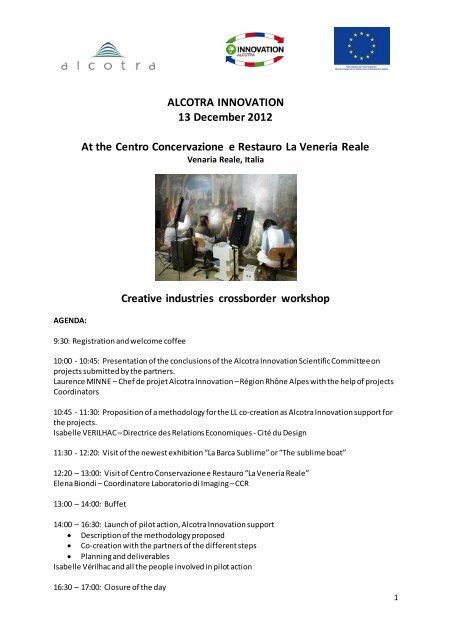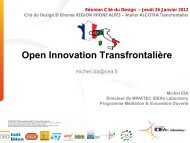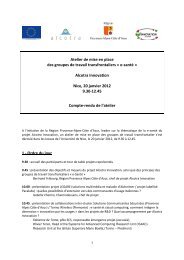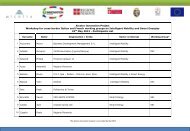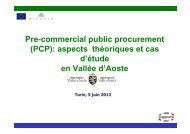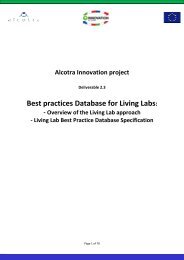ALCOTRA INNOVATION - ALCOTRA - Innovazione
ALCOTRA INNOVATION - ALCOTRA - Innovazione
ALCOTRA INNOVATION - ALCOTRA - Innovazione
You also want an ePaper? Increase the reach of your titles
YUMPU automatically turns print PDFs into web optimized ePapers that Google loves.
<strong>ALCOTRA</strong> <strong>INNOVATION</strong><br />
13 December 2012<br />
At the Centro Concervazione e Restauro La Veneria Reale<br />
Venaria Reale, Italia<br />
AGENDA:<br />
9:30: Registration and welcome coffee<br />
Creative industries crossborder workshop<br />
10:00 - 10:45: Presentation of the conclusions of the Alcotra Innovation Scientific Committee on<br />
projects submitted by the partners.<br />
Laurence MINNE – Chef de projet Alcotra Innovation – Région Rhône Alpes with the help of projects<br />
Coordinators<br />
10:45 - 11:30: Proposition of a methodology for the LL co-creation as Alcotra Innovation support for<br />
the projects.<br />
Isabelle VERILHAC – Directrice des Relations Economiques - Cité du Design<br />
11:30 - 12:20: Visit of the newest exhibition “La Barca Sublime” or “The sublime boat”<br />
12:20 – 13:00: Visit of Centro Conservazione e Restauro “La Veneria Reale”<br />
Elena Biondi – Coordinatore Laboratorio di Imaging – CCR<br />
13:00 – 14:00: Buffet<br />
14:00 – 16:30: Launch of pilot action, Alcotra Innovation support<br />
• Description of the methodology proposed<br />
• Co-creation with the partners of the different steps<br />
• Planning and deliverables<br />
Isabelle Vérilhac and all the people involved in pilot action<br />
16:30 – 17:00: Closure of the day<br />
1
PARTICIPANTS:<br />
Contact Fonction Organisme<br />
BIONDI Elena Image Lab Coordinator Fondazione Centro Conservazione e Restauro<br />
La Venaria Reale<br />
CAILLOL Philippe Operational Manager CEA Minatec Ideaslab<br />
CAPELLO Paola Project Officer <strong>ALCOTRA</strong> <strong>Innovazione</strong>, Region Piemonte<br />
CHIESA Mario<br />
Senior Researcher, User experience,<br />
interaction design<br />
Istituto Superiore Mario Boella<br />
CONJARD Antoine CEO Théâtre Hexagone<br />
CROS Magali Innovation project manager Conseil Général de l’Isère (CG38)<br />
DI FALCO Sara Project Officer <strong>ALCOTRA</strong> <strong>Innovazione</strong>, Regione Piemonte<br />
GARIBOLDI Alessandra<br />
Fondazione Fitzcarraldo<br />
LELIEVRE Edwige Teacher – Researcher Université de Savoie<br />
Prof. LUGHI Giulio<br />
Media, New Media& Communication<br />
Sociologist<br />
University of Turin<br />
MANGYOKU Mikael Project manager Cité du design<br />
MARTIN Yves-Armel CEO ERASME<br />
MAZALI Tatiana Social researcher University of Turin<br />
2
MINNE Laurence European Project Manager Région Rhône Alpes<br />
PIGUET Hélène Cultural project manager Conseil Général de l’Isère (CG38)<br />
REGIS Annalisa<br />
Fondazione Fitzcarraldo<br />
SELO Tanguy CEO IMAGINOVE<br />
SUPPINI Alessandra<br />
University of Turin<br />
VERILHAC Isabelle Economic relations director Cité du design<br />
EXCUSED<br />
FRIBOURG Bertrand Project manager PACA<br />
REVIRON Pierre-<br />
Emmanuel<br />
CEO<br />
BYPE<br />
VERGES Emmanuel CEO L’Office<br />
ZARAMELLA Tessa<br />
Servizio Programmazione<br />
Attività Produttive<br />
Provincia di Torino<br />
Please note that all the presentations will be available on the Alcotra Innovation website:<br />
http://www.alcotra-innovation.eu/<br />
3
Creative industries pilot action - Presentation by Laurence Minne:<br />
Why should we develop a cross border Living Lab:<br />
To promote the links, answers, needs/desires of end-users and align the local authorities according<br />
to the strategic plan (one of the main deliverables of <strong>ALCOTRA</strong> Innovation project).<br />
Opportunities for <strong>ALCOTRA</strong> participants:<br />
• introduction to the Living Lab approach and help in setting up a Living Lab<br />
• feasibility study<br />
• funds research<br />
• experimentations<br />
• link to European Network of Living Labs (ENoLL)<br />
Planning:<br />
• December 2012 to April 2013: kick off pilot actions; signature of a consortium agreement;<br />
pilot action follow up (State of the art, return on studies, experimentations, funding<br />
research, etc.)<br />
• May 2013 to July 2013: evaluation of activities<br />
• May 30 th 2013: Innovation Day in Torino<br />
• End of June 2013: Writing of the strategic plan<br />
• September 2013: Final conference in Genoa (Italy)<br />
• October 2013: End of project<br />
Paola Capello: Innovation day will be an event (maybe a workshop). Pilot action results should not<br />
be shared during this event as they will not be ready or mature. However it will be a good<br />
opportunity to share <strong>ALCOTRA</strong>’s ambitions to the political sphere.<br />
4
PAVHILLOnS (Performing Arts, Virtual Heritage and Interactivity: a Living Lab<br />
On/off Site) - Project presentation by Elena Biondi & Mario Chiesa<br />
Objectives: To create the framework of a cross border Living Lab where it is possible to experiment<br />
the future of museums, new approaches with performing arts. Museum and performing arts can<br />
create new experiences and lead to the exploration of new solutions. There should be the<br />
involvement of artists, 3D and 4D () technology, immersive environments (caves), avatars…<br />
Partners:<br />
• CEA, MINATEC IDEAs Lab<br />
• Conseil Général de l’Isère (CG38)<br />
• Hexagone - Atelier Arts-Sciences<br />
• ERASME (CG69)<br />
• Centro Conservazione e Restauro « La Veneria Reale »<br />
• Istituto Superiore Mario Boella<br />
• Fondazione Fitzcarraldo<br />
• Università di Torino<br />
Overview of activities:<br />
• Definition of new paradigms<br />
• Discovery of new interactions while staying under the umbrella of the LL approach<br />
• Create open workshops<br />
How can this be achieved: It is essential to involve different stakeholders (museums, research<br />
institutes, companies, public organizations, artists and actors from performing arts) and to find<br />
funding opportunities (FP7, Horizon 2020).<br />
DISCUSSION:<br />
Antoine Conjard: Could we work with Festival des Collines<br />
Edwige Lelievre: Do you think of a specific target audience<br />
• Yes the general public: museum and theatre amateurs.<br />
Fitzcarraldo foundation: More focus is needed if the target is too broad then it is possible to lose it.<br />
Who precisely is your target Is it a virtual audience or a “real world” audience<br />
Magali Cros: How can you enlarge the audience How the museum can come to them Is it possible<br />
to have a mobile museum<br />
5
Yves Armel Martin: PAVHILLOnS is a framework, we may focus on different specific projects under<br />
the umbrella of PAVHILLOnS. We have to be broad in the early project phase and narrow in the<br />
concrete applications phase.<br />
Conclusion of the <strong>ALCOTRA</strong> experts (Francesco Molinari, Jens Schumaher, and 3<br />
regional experts from Rhône Alpes, PACA and Piemonte), presented by Laurence<br />
Minne:<br />
Consortium: Very good composition but two suggestions however:<br />
• Include clusters and companies<br />
• Enhance project involvement in LL approaches<br />
Project quality: Real objectives should be clarified, not only the methodology.<br />
State of the art: This element was missing during the expert study but is currently on track (delivery<br />
before the next workshop in January / February 2013).<br />
Living Lab approach: Museomix and LUPI approach must be leveraged<br />
Cross-regional: Obvious element, no need for detail.<br />
Sustainability of the LL project: Sustainable and long term projects are key success factors.<br />
Economic and social impact: SMEs from creative industries and consumers (from associations for eg.)<br />
should be encouraged to participate actively to the projects.<br />
Feasibility assessment: Focus should be made on the methods, tools and research purposes.<br />
Budget: There is no information on the amount of partner co-financing. An estimated budget is<br />
provided.<br />
6
Museomix and Museolab presented by Yves-Armel Martin<br />
Museeolab :<br />
Museolab philosophy: Everything starts from technology<br />
Stakeholders are: artists, tech-oriented people and culture professionals<br />
Professionals live the actual experience before ideation and then experimentations are set in real<br />
situation.<br />
What is the outcome of Museolab Innovative uses of technology in museums, open-source tools,<br />
community of users (museums)<br />
Museomix:<br />
Museomix in a nutshell: 3 days to remix a museum<br />
Museomix is an open and connected event, like a participative museum<br />
The events are strongly inspired by hackathons (very popular in IT world)<br />
Last Museomix produced 10 prototypes, from which 4 will be kept as permanent in a museum in<br />
Lyon.<br />
7
Communicating wall project, presented by Emmanuel Vergès via Skype:<br />
Communicating wall is a technology oriented project focusing on multi-touch devices.<br />
Objective: How do you implement this technology in museums<br />
Strength: A rich state of the art is already present and SMEs are also already strongly involved.<br />
Proposal: This project could be complementary to the PAVHILLOnS project (as a museum application)<br />
Consortium: Project should include SMEs & clusters like IMAGINOVE for example.<br />
PAVHILLOnS and Communicating wall projects should improve contacts through common<br />
methodologies.<br />
Economic aspects: need to be developed<br />
How can we improve the consortium<br />
Isabelle Vérilhac:<br />
• This is possible through a joint experimentation open to all partners and/or a co creation<br />
pilot action.<br />
There are for instance small initiatives that act as good proofs of concept, like the LUPI methodology.<br />
LUPI promotes and enhances culture mix within an entity (public or private) by involving all the LUPI<br />
participants (CEO, product manager, engineers, designers, salespersons etc…) in all the project<br />
phases (end-user interviews, use scenario workshops etc...)<br />
It is also important to assess the proposals by launching 1 or 2 experimentations with the end-users<br />
What will be tomorrow’s cross border LL<br />
8
Proposal of a methodology for the LL co-creation as Alcotra Innovation support<br />
for the projects, presented by Isabelle Vérilhac<br />
Step 1: Sharing the state of the art:<br />
• Cité du design, design research department will provide a state of the art on creative<br />
industries and multimedia (focusing on the regions involved in <strong>ALCOTRA</strong>)<br />
• Provence-Alpes Côte d’Azur (PACA): Citymedia will share its experience on the<br />
implementation of the Communicating wall in two libraries.<br />
• Universtà di Torino: Giulio Lughi will provide the “Guidelines for Digital Creativity projects":<br />
DIGILINE project.<br />
Step 2: Observation of end users<br />
• These observations could occur in museums (Italy and France).<br />
• 10 to 12 end-user observations could be enough.<br />
• These observations should be conducted in a co-creative way.<br />
Step 3: Use scenario test with end-users<br />
• Definition of the subject<br />
• Definition of the users (typology, profiles)<br />
• Definition of the territory<br />
• What is a cross-border LL<br />
DISCUSSION<br />
Paola Capello: There is concern about the timeline, how much time will the experimentation last<br />
Preparatory work could take long so it may not suit with the project deadline (October 2013).<br />
Isabelle Vérilhac: Planning will depend on the number of experimentations (among other aspects).<br />
Consortium is already composed, with the partners of the 2 projects, and people present in this<br />
meeting. So we could start quickly..<br />
Alessandra Suppini: State of the art is already very rich, we already have a lot of knowledge on the<br />
question: “Why do people go to the museum” Maybe a starting point would be to present a<br />
technology to the users and see how it is apprehended. (Cf. Museolab)<br />
Philippe Caillol: We must link this actual workflow with the one presented on PAVHILLOnS project.<br />
Elena Biondi: We must focus on the scenario before sharing SoAs (state of the art). It will be<br />
important to prepare to this particular workshop by processing the knowledge (from Cité du design<br />
and from PAVHILLOnS). SoAs could be shared beforehand via Dropbox.<br />
9
Mario Chiesa: If we share SoAs before first workshop, do we need observations in the museums If<br />
yes, we will need some material before going to the observation. Could we organize a hackathon (like<br />
Museomix)<br />
Yves-Armel Martin: Artists and techs should be involved at workshop 1. There should be lead to<br />
connections between Communicating wall tech people and the artists who were involved in previous<br />
Museomix.<br />
Hélène Piguet: We have 10 teams already working in museums. We have to share the<br />
experimentations and skills:<br />
1. We must create a community of users.<br />
2. We must confront and share different ways of thinking the museum: Enhance interactions<br />
between curators and artists<br />
3. How can we propose something different and new for the end-users<br />
Isabelle Vérilhac: The museum observation phase is important in order to be “in real life”. Outcome<br />
of workshop 1 will be to prepare this observation.<br />
Giulio Lughi: It is mandatory to have return on investment (ROI) for public institutions:<br />
1. Living Labs have a purpose, if we can find a middleware between consumer and users.<br />
Projects don’t have the resources to reach the market (Cf. Invisibilia). LL should help them to<br />
confront the project before tackling financial issues.<br />
2. Strength of <strong>ALCOTRA</strong>: multi-culturality, because we have to balance between a local point of<br />
view (Communicating wall) and a more global view (PAVHILLOnS)<br />
Paola Capello: If we focus on museums, for example a small museum in the Piemonte mountains or<br />
an Egyptian museum. We must go there with some kind of identikits (same as research probes). It is<br />
important to mix artists and business people.<br />
Tatiana Mazali: Provided that we only have a 6 months project life span, it is not realistic to launch a<br />
Museomix in Italy. A one day hackathon may be just enough and more feasible.<br />
• Proposal: One hackathon day in France, the other in Italy Outcome of these Hackatons must<br />
be experimental objects/experience that can be tangible for the end-users.<br />
10
Proposal of another methodology for the LL co-creation, presented by Elena<br />
Biondi and Mario Chiesa<br />
DISCUSSION<br />
Yves-Armel Martin: For a one day hackathon, given the short time-frame: we can do a « video »<br />
prototype. Also answers can be non-technological!<br />
Hélène Piguet: We have strong Italian heritage in Grenoble and a strong technological legacy like the<br />
Maison Bergès: Musée de la Houille Blanche in Isère.<br />
Philippe Caillol : What is the LL of tomorrow We must test prototypes very quickly: start with<br />
anything and learn by doing. => Don’t talk, do!<br />
Isabelle Vérilhac: SoAs will be shared via <strong>ALCOTRA</strong> intranet (ACTION1: Laurence will send the link to<br />
the partners).<br />
Yves-Armel Martin: It may be possible to create a call for artists to reinforce their involvement in the<br />
workshops.<br />
Antoine Conjard: In order to involve the artists, what will be the incentive Will the artists be paid<br />
Isabelle Isabelle: There is already an allocated budget for paying the designers in the experimentation<br />
planned. Therefore it is possible to pay the artists.<br />
Alessandra Suppini: Proposal: two workshops in two museums (one in Italy and one in France).<br />
Museums are not defined yet but we have to check the number of visits of selected museums.<br />
Yves-Armel Martin: A working team must not exceed 6~7 persons, in order to maintain a “creative<br />
atmosphere”<br />
Team composition proposal: 1 SME +1 curator +1 end-user (from a museum association) +1<br />
designer + 1 artist +1 tech=6 persons<br />
11
(ACTION2: Yves Armel will make a proposal of Museomix adaptation to Laurence et Isabelle).<br />
Philippe Caillol: In order to create an economical aspect to the Living Lab, a company could be invited<br />
to test their prototype.<br />
Decisions<br />
• Create an Intranet Alcotra “creative industries”<br />
• Do the observations of users with multidisplicinary team(s) in Museum<br />
• Do a first day workshop to focus the subject<br />
• One observation in France, one in Italy<br />
Next meetings<br />
19 th February 2013 Turin 1 Day Workshop to find focus and<br />
theme for next activities<br />
8-9-10 th April 2013 French museum 1 st “Transmuseobs” (“hackathon” +<br />
user observation) : 3 days<br />
.<br />
27-28-29 th May 2013 Italian museum 2 nd “Transmuseobs” (“hackathon” +<br />
user observation) : 3 days<br />
12
Annexes<br />
13


